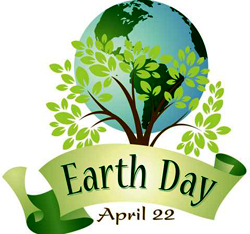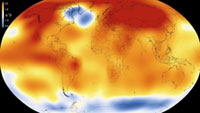April 2019 Environment
Sakshi Education
- World Earth Day: 22 April
 World Earth Day is observed every year on 22 April.
World Earth Day is observed every year on 22 April.
On 22nd April 2009 the United Nations General Assembly adopted a resolution declaring 22nd April as the 'International Mother Earth Day'.
World Earth Day 2019 theme is ‘Protect Our Species’.
It will mainly focus on saving species which are on the verge of extinction due to climate change, deforestation, pollution and illegal poaching.
- New level of complexity in dolphins: Study
A new study has found that there are hundreds of sounds that the dolphins use to communicate.
The study was published in the Journal ‘PeerJ’.
The Araguaian dolphins, also called botos, are hard to find and difficult to study.
They identified 237 different types of sounds that the dolphins make.
- India ranked 17th in Global Startup Ecosystem
According to data released by Startup Blink, India moved up to 17th position in 2018 from 37th spot last year in the Startup Ecosystem Ranking for 2019.
The top three spots remained unchanged with the United States, United Kingdom and Canada.
The cities with the most vibrant startup ecosystems in India are Bangalore, New Delhi, and Mumbai.
- Indonesia's Mount Agung erupted again
The active volcano of Indonesia Mount Agung has erupted again to a height of 2km.
Two other volcanoes popular with tourists Mount Bromo in East Java and Mount Merapi inYogyakarta also continues to erupt.
Mount Agung is an active volcano in Bali of Indonesia.
- Low-pressure system over South Bay of Bengal likely to turn into cyclonic storm: IMD
Indian Meteorological Department in Chennai has issued a warning that a low-pressure system over the south Bay of Bengal would turn into a cyclonic storm which has been named Fani.
The system which is a low pressure now in the Indian Ocean adjoining the south-east Bay of Bengal is expected to turn into a depression during the next 24 hours.
A weather warning has been issued to the fishermen to return to the coasts immediately as the sea along the coasts of Tamil Nadu and South Andhra, are on the predicted areas.
- Earth’s surface heating up: NASA study
 Satellite measurements by NASA researchers have verified the ground- based data which shows the Earth's surface has been warming globally over the past 15 years.
Satellite measurements by NASA researchers have verified the ground- based data which shows the Earth's surface has been warming globally over the past 15 years.
The team used measurements of the 'skin' temperature of the Earth taken by a satellite-based infrared measurement system called AIRS from 2003 to2017.
- Workshop on Loss & Damage conducted
A 1-day National Consultation on Loss and Damage was hosted by the Ministry of Environment in New Delhi on 16 April 2019.
India has been experiencing weather and climate-related loss and damage, the Kerala floods and Ockhi being the rarest of the rare events.
The workshop had 2 technical sessions on topics including ‘Strengthening response to address loss and damage’.
- 220 million year old dinossaur fossils found
A site containing the 220-million-year-old fossilised remains of nearly a dozen dinosaurs has been discovered in western Argentina.
There are almost ten different individuals, it's a mass of bones, there's practically no sediment.
This discovery is doubly important because there are at least seven or eight individuals of dicynodonts, the ancestors of mammals, the size of an ox.
- UN report on major industrial accidents
The 1984 Bhopal gas tragedy is among the world's 'major industrial accidents' of the 20th century, as per a UN report.
2.78 million Workers die from occupational accidents and work-related diseases each year.
The report titled 'The Safety and Health at the Heart of the Future of Work -Building on 100 years of experience'.
It was released by the International Labour Organization (ILO).
- High proportion of antibacterial Agents in Ganga
A study found that the river water of Ganga contains a significantly higher proportion of organisms with antibacterial properties.
The study, ‘Assessment of Water Quality and Sediment To Understand Special Properties of River Ganga,’ began in 2016 and was conducted by the National Environmental Engineering and Research Institute.
- Global coalition for clean cooling launched
 The first-ever global coalition on clean and efficient cooling was launched at the First Global Conference on Synergies between the 2030 Agenda and Paris Agreement, which concluded on April 3, 2019, in Copenhagen, Denmark.
The first-ever global coalition on clean and efficient cooling was launched at the First Global Conference on Synergies between the 2030 Agenda and Paris Agreement, which concluded on April 3, 2019, in Copenhagen, Denmark.
The Global Coalition links action across the Kigali Amendment, Paris Agreement and Sustainable Development Goals.
India has developed its National Cooling Action Plan.
- A village with carbon-positive tag
Phayeng in Manipur has become India’s first carbon-positive settlement.
A village is given the carbon-positive tag if it sequesters more carbon than it emits, slowing the accumulation of greenhouse gases and mitigating the effects of climate change.
As part of the carbon-positive village project, Phayeng will receive a grant of Rs.10 crore in phases to facilitate Afforestation.
- Yellow weather warning for Himachal Pradesh
The Meteorological Department issued a yellow weather warning for rain in Himachal Pradesh.
The weather department forecast thunderstorm with hail in isolated places of mid hills, including Shimla, Mandi, Kullu, Chamba, Solan, and Sirmaur.
Yellow is the least dangerous of the weather warnings - it indicates the possibility of severe weather over the next few days that could affect people.
- Melting of Arctic ice impacts India
Researchers found that rising temperatures in the region is causing the sea ice to melt faster than expected.
The study was conducted by Germany-based Alfred Wegener Institute (AWI), Helmholtz Centre for Polar and Marine Research.
The faltering of Transpolar Drift could lead to weather implications across countries, including India.
- National Green Tribunal (NGT) forms committee to look into Yamuna floodplain erosion in Sonipat
The National Green Tribunal (NGT) on 08 April 2019 formed a committee to look into the alleged erosion of Yamuna floodplain due to movement of heavy vehicles in Haryana's Sonipat district.
A bench headed by NGT Chairperson Justice Adarsh Kumar Goel constituted a committee comprising the principal secretary of the Haryana Irrigation and Water Resources Department, member secretary of the Haryana State Pollution Control Board and the director of the Mines and Geology Department.
The nodal agency for coordination and compliance will be the principal secretary of the Haryana Irrigation and Water Resources Department.
The tribunal said the committee would submit a joint report within one month by e-mail so that matter can be taken up before the monsoon. The next hearing in the matter is due on May 24.
- 6.2 magnitude earthquake strikes off coast of Ecuador

A strong 6.2 magnitude earthquake struck off the coast of Ecuador on 31 March 2019. According to the US Geological Survey there were no immediate reports of damage or tsunami warning.
The quake occurred at a depth of 18.5 kilometers in the Pacific Ocean west of Guayaquil and 27 kilometers north of Santa Elena.
- WWF sounds alarm after 48 lbs of plastic found in dead whale
The garbage recovered in the sperm whale’s stomach included a corrugated tube for electrical works, plastic plates, shopping bags, tangled fishing lines and a washing detergent package with the brand and bar code still legible.
The garbage recovered in the sperm whale’s stomach included a corrugated tube for electrical works, plastic plates, shopping bags, tangled fishing lines and a washing detergent package with the brand and bar code still legible.
An 8-meter (26-foot) sperm whale was found dead off Sardinia with 22 kilograms (48.5 pounds) of plastic in its belly, prompting the World Wildlife Foundation to sound an alarm Monday over the dangers of plastic waste in the Mediterranean Sea.
The environmental group said the garbage recovered from the sperm whale’s stomach included a corrugated tube for electrical works, plastic plates, shopping bags, tangled fishing lines and a washing detergent package with its bar code still legible.
The female whale beached off the northern coast of Sardinia last week, within the vast Pelagos marine sanctuary that was created as a haven for dolphins, whales and other sea life.
The exam also determined that the whale was carrying a fetus that had died and was in an advance state of decomposition. Experts said the mother whale had been unable to digest calamari due to the huge amount of plastic it had ingested, filling two-thirds of its stomach.
WWF said plastic is one of the greatest threats to marine life and has killed at least five other whales that had ingested large amounts of it over the last two years from Europe to Asia.
Another sperm whale died off the Italian island of Ischia, near Naples, last December (2018) with plastic bags and a thick nylon thread in its stomach, but plastic was not the cause of death.
The World Wildlife Foundation said between 150,000 and 500,000 tons of plastic objects and 70,000 to 130,000 tons of micro-plastics wind up in Europe’s seas each year.
To combat the phenomenon, the European Parliament last week approved a new law banning a wide range of single-use plastic products, including plates and straws, starting in 2021.
Italy’s environment minister, Sergio Costa, lamented the whale’s death and said he planned to propose a new law this week to limit the use of plastics.
The law will permit fishermen to bring plastics recovered at sea to land for proper disposal, which they currently are barred from doing. Costa also pledged Italy would be one of the first countries to enact the European single-use plastics ban and appealed to the mayors of Italian cities and coastal towns to adopt the ordinances in advance of the 2021 law.
- Over 1.2 million early deaths in India due to air pollution
A global report has found that life expectancy of children born today will be shortened by 20 months on average, growing up in current high levels of air pollution.
According to a study, conducted by the Boston-headquartered Health Effects Institute, the situation in South Asia is much worse with the life expectancy shortened by two years and six months.
The institute’s State of Global Air Report 2019, released on 03 April 2019, said that overall long-term exposure to outdoor and indoor air pollution contributed to nearly 5 million deaths across the world from stroke, diabetes, heart attack, lung cancer, and chronic lung disease in 2017.
This means that air pollution contributed to nearly one in every 10 deaths in 2017, making it a bigger killer than malaria, malnutrition, and road accidents.
The report said that out of the 5 million, 3 million deaths are directly attributed to PM2.5, half of which is from India and China together.
The analysis found that China and India together were responsible for over half of the total global attributable deaths, with each country facing over 1.2 million deaths from all air pollution in 2017.
- Bleaching hits world’s southernmost coral reef
Phenomenon indicates that climate change is affecting even remote spots, says scientist. The world’s southernmost coral reef has been hit by bleaching this summer, Australian scientists said on 03 April 2019, as they warned rising sea temperatures from climate change were affecting even the most isolated ecosystems.
The corals off Lord Howe Island — some 600 km offshore from Sydney — were affected by elevated temperatures this summer, despite escaping severe bleaching that damaged the Great Barrier Reef in 2016 and 2017.
It’s a canary in the coal mine that bleaching at this very isolated southernmost reef. It’s just another indicator that climate change is affecting everywhere around the world. Here is a reef that is 600 km from the mainland and we are seeing bleaching there in a lovely, beautiful ecosystem.
Shallow lagoons
Australian universities and the U.S. National Oceanic and Atmospheric Administration found severe bleaching of up to 90% at Lord Howe’s inshore, shallow lagoon reefs.
Deeper-water corals in the marine park, which contains species not found anywhere else and like the Barrier Reef is a World Heritage site, were still “looking quite healthy” having mostly escaped the bleaching.
Increasing baseline temperatures caused by climate change, and local factors such as elevated temperatures in the area this summer, caused the bleaching to occur.
The scientists are set to return to Lord Howe in the next few months to find out if some corals have been so severely bleached they can’t recover.
Bleaching occurs when abnormal environmental conditions, such as warmer sea temperatures, cause corals to expel tiny photosynthetic algae, draining them of their colour.
- Skymet sees below-normal South-West monsoon
This year’s South-West Monsoon (June-September) is likely to be ‘below normal’, at around 93 per cent of the long-period average (LPA), private forecaster Skymet Weather said on 03 April 2019.
This is the first early forecast for the 2019 season. The India Met Department (IMD) is expected to come out with its own forecast by mid-April.
A preliminary monsoon forecast guidance by Skymet on February 25 had predicted normal rains. It kept the probability of normal monsoon at about 50 per cent, but also alluded to a ‘significant chance’ of rainfall ending below normal. This was based on January projections, which indicated that chances of El Nino were fading rapidly.
But the scenario changed completely in February, with moderate El Nino conditions emerging over the Pacific Ocean.
The Pacific is now strongly warmer than average. Model projections indicate 80 per cent chance of El Nino conditions during March-May, dropping to 60 per cent for June-August.
It is going to be a devolving El Nino year, though retaining threshold values all through the season.
Thus, monsoon 2019 is likely to be below normal.
The onset month of June may prove to be sluggish and the resultant rain deficit may spill into July.
The second half of the season would, however, see better rainfall.
- Saving the Olive Ridleys of Visakhapatnam Coast
Visakhapatnam is one of the important sporadic nesting zones for the Olive Ridley Sea Turtles on the East Coast.
Every winter, thousands of them come ashore to lay their eggs. The coast of Odisha still remains a site of mass nesting, places like Visakhapatnam, Srikakulam and Vizianagaram in Andhra Pradesh are also seeing an increase in the number of nests Divisonal Forest Officer.
This year in Visakhapatnam over 80,000 eggs where collected of which 10,000 hatchlings have been released so far.
The turtles that predominately come to Visakhapatnam from the Mexican coast, mate at sea and then come ashore to lay clusters of eggs on the beaches.
Females dig holes in the sand to lay the eggs, cover them and return to the sea. The eggs hatch in a span of 45 to 60 days depending upon the temperature.
Tiny turtle hatchlings make their way from the nest to the sea, using the light from the horizon as their guide.
However, due to rapid urbanization of coastal areas, lights from hotels and buildings near the coast confuse the hatchlings and they go astray. That is why releasing the hatchlings has become an important part of the conservation process.
In an attempt to conserve the eggs, and prevent the death of hatchlings due to human interference and stray dog menace, the Forest Department built hatcheries.
National Thermal Power Corporation Limited Simhadri as a part its CSR activity is funding the Forest Department for the turtle conservation project that was launched in the fiscal year 2015/2016. Rs.4.6 crore was granted for this.
NTPC has so far released Rs.4 crore in four installments and the remaining Rs.60 lakh will be released shortly.
What can you do to help in conservation?- Keep the beaches clean
- Keep away from the nesting zones
- Volunteer for the conservation for collecting eggs and releasing the hatchlings.
- The eggs that are laid along the coast are brought and buried in these hatcheries. At present, there are five hatcheries across the city at RK Beach, Appu Ghar, Jodugulla Palem, Pedda Nagamayya Palem and Tantadi.
- Among the five hatcheries, the survival rate of hatchlings at the RK Beach is one of the lowest thanks to pollution, littering and human interference.
Published date : 15 Apr 2019 06:09PM


















